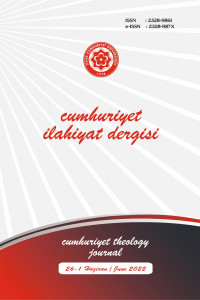Kur’an’da el-Cin Kavramının Medlûlü Hakkındaki İhtilaflar
Disputes on the Meanings of the “al-Jin” in the Qur’ān
Author(s): Bayram DemircigilSubject(s): Islam studies, Religion and science , 6th to 12th Centuries, Qur’anic studies
Published by: Cumhuriyet Üniversitesi İlahyat Fakültesi
Keywords: Exegesis; The Qur’ān; Polysemic Words; al-Jinn; Context;
Summary/Abstract: Polysemic words and phrases in the Qur’ān gave rise to disagreements in the Qur’ānic exegesis. Therefore, it seems obligatory to refer to the contextual reading of the text while interpreting and understanding the polysemic vocabularies. One of the polysemic vocabularies is the word al-jinn, which derives from janna – yajunnu, which means to cover something. The use of this word is related to the fact that they are supernatural beings and are invisible to the eye. The same feature is described for angels, which are considered part of the concept of “al-jinn” on the same level. In the period of Ignorance (Jāhiliyyah), these beings were portrayed as having extraordinary spiritual powers. Even some people believed that they deserved to be worshipped. But the Qur’ān strongly rejected this ascription. The early exegetes of the Qur’ān and later scholars vary in terms of the meaning of “al-jin” whether this word in these verses refers to the jinns or the angels or the Devil or satans. The disputes in this regard occurred in some verses where the word al-jin or al-jinnat were placed in their absolute forms. On the other hand, the absolute use of the word al-ins or al-nās did not become one of the dispute topics, except for some contemporary interpretations and approaches. Within these disagreements, the discussions had been made about the distinction between the jinns and angels or the innocence of angels. The majority of exegetes acted more or less following the context where they analysed the polysemic words. Also, it should be noted that focusing on the relevant etymological meaning is one of the major interpretation methods in exegesis while specifying the exact meaning of the word. Therefore, this study starts by exploring how the people perceived this concept in the Arabian Peninsula during the period of Jāhiliyyah. The importance of methodological tools appears by considering that the Qur’ānic revelation took place in the forms of language used in the 7th century of the Arabian Peninsula. This influenced the way some scholars tackled the issue. Therefore, we first dealt with the specific meanings of “al-jinn” used by the Jāhiliyyah Arabs. We also referred to the classical Arabic dictionaries to determine the linguistic ground for the explanations in the Qur’anic exegesis. Besides, we gave place to the historical narrations related to this subject. Disagreements among exegetes in this regard occurred on the meaning “al-jinn”, whether the Devil (Iblis) can be considered as an angel, and what is meant by “al-jinnat” by which polytheists ascribed kinship between them and Allah. Some scholars analyse the matter by intra-textual context, while others focus on extra-textual context or both. It seems that the most distinguished scholars that take the contextual indications into account during the process of interpretation are Muqātil, Faḫruddīn al-Rāzī, and İbn ʽĀshūr. We also should indicate that the same verses might be used for different argumentations. Within this regard, as some authors argue, it is possible to come to a conclusion that the exegetes throughout history were aware of the historical and cultural context of Arabs who associated the jinn and angels with Allah. The exegetes addressed the issue from the perspective of whether angels are sinless or innocent. In this respect, some scholars’ perception of the angel is quite different from those who assert that Iblis was one of the angels. We also should not dismiss the fact that Isrāiliyāt had some effect in nourishing this perception. We also need to consider that the principles of Sunni doctrine had a more substantial impact on some scholars like Rāzī. In recent years, some authors have argued that the jinns who worked under the service of the Prophet Salamon and those who met the Prophet Muhammed (PBUH) were foreign people from different tribes. We should indicate that this interpretation does not reflect a correct understanding. This viewpoint attempts to explain the issue contemporarily and from a rationale perspective and is possibly inspired by narratives in the Bible.
Journal: Cumhuriyet İlahiyat Dergisi
- Issue Year: 26/2022
- Issue No: 1
- Page Range: 433-449
- Page Count: 18
- Language: Turkish

